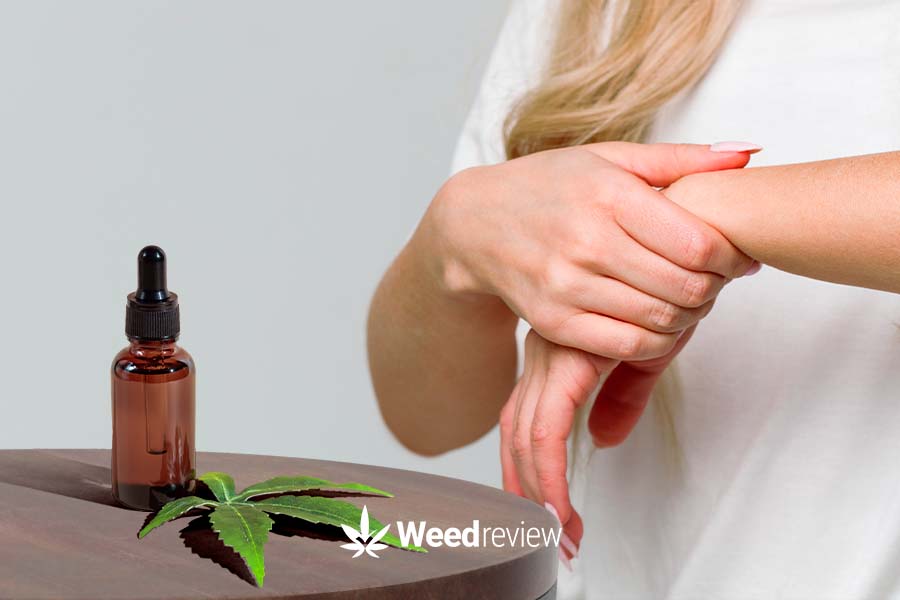
CBD for Joint Pain & Arthritis: Medicinal Potential, Products, How to Use

Table of Contents
Joint pain and arthritis affect the lives of millions of people worldwide. In Thailand, the Ministry of Public Health reported that over six million people suffered from knee osteoarthritis in 2018.
Arthritis is marked by inflammation and stiffness in the joints, leading to chronic discomfort and limited mobility. There is growing interest in the potential of medicinal marijuana – particularly CBD (cannabidiol) – in easing joint pain and arthritis symptoms.
CBD has gained attention for its ability to deliver medicinal benefits without the psychoactive effects associated with cannabis. While research on CBD is ongoing, studies suggest that it may provide anti-inflammatory and analgesic effects. It is a promising natural alternative for those seeking relief from joint pain.
In this article, we will explore the mechanisms behind CBD’s potential for arthritic pain and discuss how to choose the right products for managing joint pain effectively.
Arthritis & joint pain: A quick overview
Joint pain refers to the unpleasant sensations felt in the joints, causing discomfort and soreness.
Factors causing joint pain include injuries, inflammation, or underlying medical conditions. Overuse, ageing, and certain lifestyle also contribute to this.
Arthritis is a broad term that refers to different conditions marked by joint inflammation and stiffness. The most common type is osteoarthritis. This occurs due to the gradual wear and tear of the joints over time. Rheumatoid arthritis, an autoimmune disease, causes chronic joint inflammation.
Common symptoms
The common symptoms of joint and arthritis pain include:
- Persistent pain or aching sensation in the affected joints
- Swelling or inflammation around the joints
- Stiffness and reduced range of motion
- Difficulty or discomfort while performing daily activities
- Sensitive/tender to touch
- Warmth or redness in the affected area
- Fatigue or general discomfort
Cannabidiol for arthritis pain
CBD is a natural compound derived from the cannabis plant. Unlike THC, it doesn’t make you high.. CBD interacts with the body’s endocannabinoid system, which regulates pain, inflammation, and other physiological processes.

What the research says
CBD has been studied greatly for its pain-relieving ability. Studies show that CBD may modulate pain perception by working with receptors involved in pain regulation.
Mentioned below is a summary of recent research in the context of joint pain:
- A 2022 study published in the Journal of Cannabis Research found that CBD significantly improved pain, physical function, and sleep quality among people with arthritis. The study also revealed a reduction or stopping of other medications, including anti-inflammatories and opioids,.
- A review study published in 2020 noted that CBD may have a role in managing the pain and inflammation associated with rheumatoid arthritis & osteoarthritis.
- Another paper titled ‘Is cannabis an effective treatment for joint pain?’ concluded that cannabinoids seem to produce beneficial effects for joint pain in animal studies. It also highlighted the need for more studies and clinical trials.
- According to the Arthritis Foundation, anecdotal evidence suggests that some people with arthritis who use CBD report noticeable pain relief, improved sleep, or reduced anxiety.
- Research also provides strong evidence to support the pain-relieving benefits of topical CBD. A 2015 animal study conducted on a rat model of arthritis demonstrated that transdermal use of cannabidiol reduced inflammation and eased pain-related symptoms.
In short, cannabidiol has the potential to:
- Reduce joint pain and improve overall comfort & quality of life.
- Enhance joint mobility and flexibility by leveraging its potential anti-inflammatory properties.
- Reduce the use of opioids and pain medicines
Safety
CBD is generally considered safe, with a low-risk profile and minimal side effects. It is not addictive. Commonly reported side effects are mild and may include fatigue, dry mouth, or changes in appetite. These depend on the type of CBD product you choose, its quality, its ingredients, and your biology.
Legality
CBD is legal in Thailand as it falls under the scope of medicinal cannabis. There are numerous dispensaries, shops, and clinics that sell CBD products. Many of them have dedicated, in-house doctors specialising in traditional Thai medicine and marijuana.
Choosing CBD for joint pain: What are the choices?
CBD is available in various forms, including oils, topicals (creams, lotions, balms), capsules, gummies, and edibles.

Weed Review strongly recommends visiting a doctor or a medical marijuana clinic to get a personalised recommendation for your condition.
Tinctures & oils
CBD oils are a popular form of CBD. They can be taken orally by placing a few drops under the tongue or added to food and beverages. Some of these can also be used as massage oil.
Oils come in three varieties: full-spectrum, broad-spectrum, and isolates.
For best results, full-spectrum is recommended as it has all major cannabinoids and terpenes which contribute to the pain-relief effect.
Tinctures offer flexibility in dosage and are quickly absorbed into the bloodstream, allowing for fast delivery of CBD. The effects are felt within 15-45 minutes and last 4-6 hours.
You will find CBD tinctures of varying concentrations, from 600 mg to 3,000 mg. The Government Pharmaceutical Organisation (GPO) has also made its own CBD formulations for medicinal uses.
Gummies & edibles
CBD gummies, including edibles, offer an easy and enjoyable way to add CBD to your daily routine. These are infused with CBD and come in delicious flavours. They come in specific doses (10 or 20 mg per gummy and so on), making it easy to plan your wellness routine.
Edibles & gummies take time to produce their effects – from 30 minutes to up to 2 hours. The said effects are long-lasting from 6-8 hours.
Flowers
CBD flowers, also known as hemp flowers, are the buds of the cannabis plant that contain high levels of CBD and low levels of THC. There are multiple strains of CBD buds with different CBD levels and terpenes. You can smoke them for fast-acting relief. You will feel the effects within minutes, but they will wear off in 3-4 hours.
You can also use these to make homemade CBD products such as oils, edibles, or topicals.
Topicals
CBD topicals, such as creams, lotions, and balms, are applied directly to the skin in the area of joint pain. These products provide localised relief by targeting the specific area of discomfort.
CBD topicals are absorbed through the skin and may offer soothing effects, potentially reducing inflammation and alleviating pain in the joints. Unlike oils or edibles, they do not enter your blood.
Hemp
The hemp plant tends to make buds with high levels of CBD. Many brands use hemp-sourced CBD for a more refined experience.
You will also find hemp oil which contains cannabinoids and terpenes.
This is not to be confused with hemp seed oil, which is made from hemp plant seeds – they are rich in antioxidants and fatty acids but have no CBD or THC.
How to choose the right CBD product
When selecting CBD products, it’s important to consider:
- High concentration & potency – starting at 500 mg
- Full or broad spectrum tinctures; the entourage effect supports relieving arthritis pain
- Choose third-party lab testing for purity and potency
- Ingredients and potential allergens
- Reviews and the reputation of the manufacturer
How to use cannabidiol for arthritis
- Try different products & doses. Each person’s body is unique, and finding the right CBD product may involve some experimentation.
- Start with a low CBD dosage and gradually increase it as needed. Listen to your body and adjust the dosage accordingly. Beginners may start with 15 to 20 mg of CBD per day. Listen to your body and adjust the dosage accordingly.
- Stay Consistent. Achieving the potential benefits of CBD for joint pain and arthritis requires regular use over time. Patience and maintaining a consistent CBD routine increase the likelihood of experiencing the desired results.
- Speak to a doctor before you add CBD to your daily routine.
The type of pain and treatments varies from person to person. Since cannabis works on each differently, there are no universal guidelines or dosages for taking cannabidiol.
There are things you can do to improve the pain-relieving effects of CBD.
Side effects & drug interactions
Common side effects of CBD include dry mouth, temporary fatigue, or changes in appetite. These side effects are usually mild and temporary. If the side effects persist, stop using the product.
CBD can interact with certain medications. It affects liver enzymes responsible for metabolising medications, thus changing their effectiveness in your body.
Common medications include NSAIDs (non-steroidal anti-inflammatory drugs) and painkillers like Celebrex.
If you are taking medicines regularly, please speak to your doctor to get the optimum dosage for CBD & your meds.
Conclusion
CBD holds potential as a natural remedy for joint pain and arthritis. With its anti-inflammatory and analgesic properties, CBD may alleviate pain, improve sleep, and enhance joint mobility.
Selecting the right product, starting with low doses, and maintaining consistency is important when using CBD. Consulting with a doctor is a good idea to ensure safety, especially in case of mixing it with other meds. While individual responses may vary, CBD promises to help improve patients’ quality of life and well-being.


